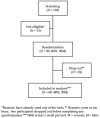Comparing the Usability of the Web-Based 24-h Dietary Recall R24W and ASA24-Canada-2018 among French-Speaking Adults from Québec
- PMID: 36364803
- PMCID: PMC9653863
- DOI: 10.3390/nu14214543
Comparing the Usability of the Web-Based 24-h Dietary Recall R24W and ASA24-Canada-2018 among French-Speaking Adults from Québec
Abstract
Automated, self-administered, Web-based 24-h dietary recall tools are increasingly available for nutrition research in different settings, particularly in epidemiological studies and national surveys because of their practicality and efficiency. However, the usability of different 24-h dietary recall tools must be assessed and compared for use in specific populations as it is a major driver of the response rate and retention of participants. The primary aim of this study was to compare the usability of two validated, self-administered, web-based 24-h dietary recall tools available for the Canadian population: the R24W and the 2018 Canadian version of the ASA24. The R24W was developed in French for primary use in the province of Québec, Canada while the ASA24 was developed in English for primary use in the USA and recently adapted and translated for use in French-speaking Canadian adults. Whether the R24W and the ASA24-Canada-2018 yield similar nutritional data was also tested. In this randomized crossover study, 48 women and 20 men (mean age of 35 ± 14 years; range: 19−79 years) recruited in the province of Quebec completed the R24W and the ASA24-Canada-2018 in French twice on each occasion. Participants also completed the System Usability Scale (SUS), a reliable and valid scale giving a global view of subjective assessments of usability. Mean SUS score as well as mean dietary intakes of energy, nutrients and food groups generated by each tool were compared using mixed model analyses for repeated measures. On a scale of 0 to 100, the mean SUS scores (±SD) for the R24W and the ASA24-Canada-2018 were 81 ± 2 and 58 ± 2, respectively (p < 0.0001). 84% of participants stated that they would prefer to use the R24W if they were invited to complete additional 24-h dietary recalls. No significant difference was found between the R24W and the ASA24-Canada-2018 for the intake of energy, proteins, lipids, saturated fatty acids, carbohydrates, fibers, sodium and vegetables and fruits. In sum, while the R24W and the ASA24-Canada-2018 generate comparable self-reported dietary intake data, the R24W showed a better usability than the ASA24-Canada-2018 in a sample of French-speaking adults from the province of Quebec.
Keywords: ASA24; R24W; dietary assessment; dietary recall; online; usability; user experience.
Conflict of interest statement
C.L., S.L., J.R. and B.L. develop the R24W. J.R. is chair of Nutrition at Université Laval, which is supported by private endowments from Pfizer, La Banque Royale du Canada, and Provigo-Loblaws.
References
-
- Schatzkin A., Kipnis V., Carroll R.J., Midthune D., Subar A.F., Bingham S., Schoeller D.A., Troiano R.P., Freedman L.S. A comparison of a food frequency questionnaire with a 24-hour recall for use in an epidemiological cohort study: Results from the biomarker-based Observing Protein and Energy Nutrition (OPEN) study. Int. J. Epidemiol. 2003;32:1054–1062. doi: 10.1093/ije/dyg264. - DOI - PubMed
-
- Freedman L.S., Commins J.M., Moler J.E., Willett W., Tinker L.F., Subar A.F., Spiegelman D., Rhodes D., Potischman N., Neuhouser M.L., et al. Pooled results from 5 validation studies of dietary self-report instruments using recovery biomarkers for potassium and sodium intake. Am. J. Epidemiol. 2015;181:473–487. doi: 10.1093/aje/kwu325. - DOI - PMC - PubMed
-
- Subar A.F., Kipnis V., Troiano R.P., Midthune D., Schoeller D.A., Bingham S., Sharbaugh C.O., Trabulsi J., Runswick S., Ballard-Barbash R., et al. Using intake biomarkers to evaluate the extent of dietary misreporting in a large sample of adults: The OPEN study. Am. J. Epidemiol. 2003;158:1–13. doi: 10.1093/aje/kwg092. - DOI - PubMed
Publication types
MeSH terms
LinkOut - more resources
Full Text Sources


